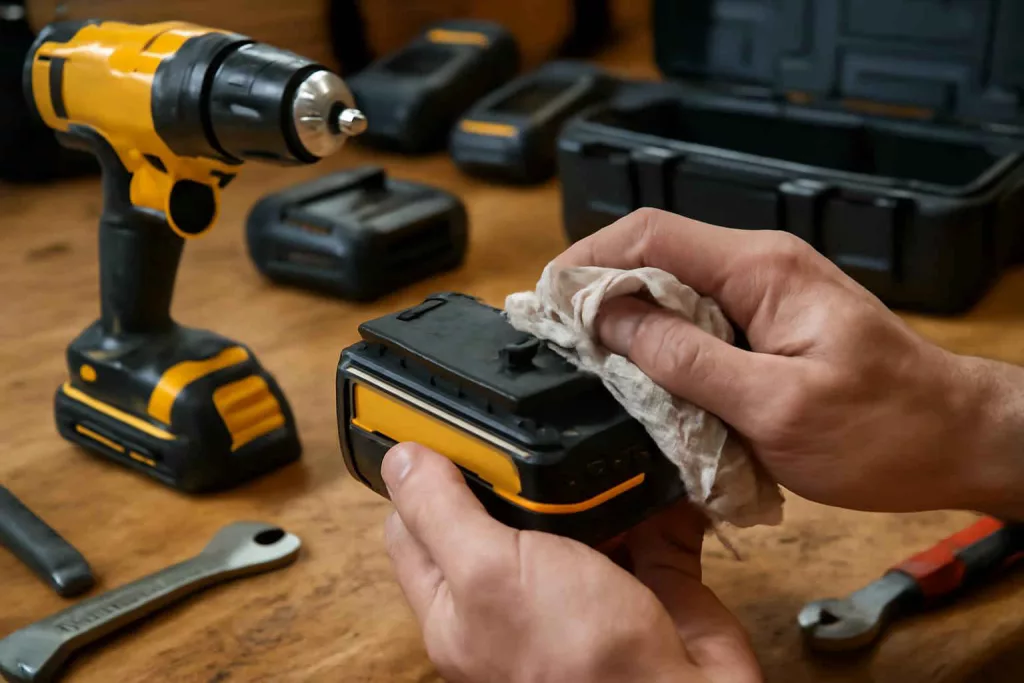Maintaining the health of your lithium-ion batteries is key to keeping your cordless power tools performing at their best. With proper care and targeted strategies, you can significantly extend life of power tool batteries, saving you money and ensuring your tools are always ready for the job. This guide covers proven practices for charging, storage, maintenance, and troubleshooting to maximize battery longevity.
To get started on optimizing battery performance, consider investing in specialized power tool battery maintenance tools early in your routine.
Understanding Lithium-Ion Tool Batteries
How Lithium-Ion Batteries Work
Lithium-ion batteries power a wide range of cordless power tools, from drills and saws to impact drivers and paint sprayers. At their core, these batteries rely on the movement of lithium ions between the anode and cathode to store and release energy. Unlike older nickel-cadmium batteries, lithium-ion cells deliver higher energy density, lighter weight, and minimal memory effect. However, they are also more sensitive to charging habits, temperature extremes, and storage conditions.
Factors Affecting Battery Life
Several variables influence the lifespan of cordless tool batteries:
- Charge cycles: Each full discharge and recharge counts as one cycle; most lithium-ion batteries are rated for 300–500 cycles.
- Temperature: High heat accelerates cell degradation, while very low temperatures reduce immediate capacity.
- Depth of discharge: Deep discharges shorten cycle life; partial discharges are preferable.
- Storage voltage: Storing batteries at 100% or 0% charge can stress cells over time.
- Charger quality: Smart chargers with temperature monitoring and balanced charging protect battery health.
Best Practices for Charging Cordless Tool Batteries
Avoid Overcharging and Rapid Charges
Modern chargers stop charging once a battery reaches full capacity, but leaving a battery on the charger for extended periods can raise cell temperature and increase internal resistance. Whenever possible, remove batteries promptly after they reach 100% and allow them to cool. If your charger offers a maintenance mode or trickle charging, use it sparingly—unsupervised topping off can still generate heat.
Use the Right Charger for Your Cells
Always match batteries to their manufacturer’s recommended chargers. Third-party or generic chargers may lack crucial safeguards like overheat protection, cell balancing, or accurate voltage detection. For example, if you own a set of battery-powered chainsaws from a specific brand, use the OEM charger designed for that battery chemistry and voltage to preserve capacity and prevent damage.
Proper Storage Techniques for Longevity
Store at the Ideal Charge Level
Most lithium-ion batteries perform best when stored at about 40–60% state of charge. This partial charge slows the chemical reactions that degrade cells. If you won’t be using a tool for several weeks or months, charge the battery to around half capacity before setting it aside.
Control Temperature and Humidity
Extreme temperatures are detrimental. Aim to store batteries in a cool, dry environment between 50–77°F (10–25°C). Avoid garages or sheds that can heat up or freeze seasonally. A climate-controlled workshop is ideal. If you’re storing batteries alongside your battery-powered lawn edgers or other seasonal tools, place them in an insulated cabinet or dedicated battery storage box.
Regular Maintenance and Care Tips
Keep Contacts Clean and Dry
Corrosion or debris on battery contacts can lead to poor connections, heat buildup, and reduced runtime. After each project, inspect contacts on both battery and tool. Use a dry cloth or compressed air to remove dust, then wipe gently with a cotton swab lightly dampened with isopropyl alcohol.
Monitor Battery Health with Diagnostic Tests
Many modern battery platforms include built-in diagnostics that display cycle count, current capacity, and health indicators on smart chargers or tool interfaces. Periodically check these readouts to spot early signs of wear. If your charger or device doesn’t offer diagnostics, consider a standalone battery analyzer to test voltage, internal resistance, and discharge curves.
Update Firmware When Available
Some advanced cordless systems, like those in professional-grade drills and impact drivers, allow firmware updates. These patches can optimize charging algorithms, balance cell voltage more effectively, and improve safety shutdown thresholds. Refer to your tool manufacturer’s website for update instructions.
Troubleshooting Common Battery Issues
Battery Won’t Charge or Holds No Charge
If a fully charged battery quickly drains or refuses to take a charge, perform these checks:
- Swap to a different charger to rule out charger faults.
- Inspect charger and battery contacts for damage or corrosion.
- Test battery on another compatible tool to see if it delivers any runtime.
- Let the battery rest overnight; lithium-ion cells sometimes recover from a protective shutdown if cooled.
If the battery still fails, retirement is likely the only safe option; reconditioning or home repairs can be dangerous.
Battery Overheating During Use or Charge
Excessive heat can be a warning sign. During use, let the battery cool by taking intermittent breaks. If overheating persists:
- Verify the tool’s motor and transmission aren’t binding or under heavy load.
- Ensure charger vents are clear of debris and placed in a well-ventilated area.
- Consider replacing batteries that are more than two years old or have undergone hundreds of cycles.
When to Replace Your Batteries
Even with impeccable maintenance, lithium-ion batteries eventually degrade. Watch for these indicators that replacement is due:
- Significantly reduced runtime (less than half of original capacity).
- High internal resistance causing tools to underperform under load.
- Swelling, leakage, or extreme overheating.
- Rapid self-discharge when not in use.
Before discarding old batteries, recycle them at a certified e-waste facility or retailer drop-off point. Many power tool brands offer battery recycling programs to ensure safe disposal.
Conclusion
By understanding the chemistry of lithium-ion cells and adopting best practices—proper charging, storage, cleaning, and diagnostics—you can dramatically extend life of power tool batteries. Consistency in maintenance routines not only saves money but also ensures your cordless tools deliver peak performance when you need them most. For secure long-term storage, consider investing in a dedicated lithium-ion battery storage case designed to shield batteries from extreme conditions and accidental short-circuits. With these strategies, your batteries—and your projects—will stand the test of time.






